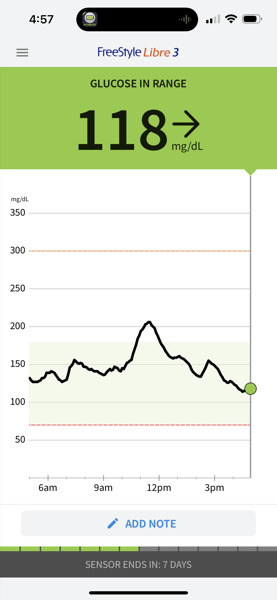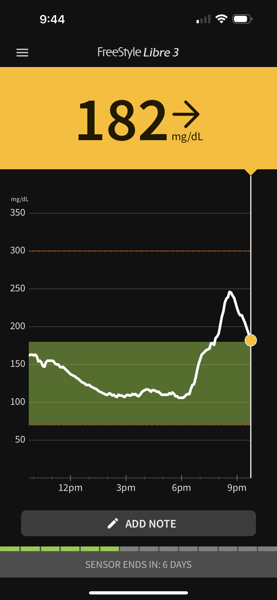Having diabetes is no fun, but from early on my favorite coping mechanism has been to try to combine managing my diabetes with my affinity for technology and cool new tools and gadgets.
When I had my first appointment with my first endocrinologist, I thought I was ahead of the curve when I said I had ordered a snazzy finger stick blood glucose monitor that had a companion iOS app. She immediately responded “no, I’m going to give you something better,” and she handed me a prescription for a system called FreeStyle Libre.
And it was indeed better than fingersticks. Instead of pricking your finger many times a day and getting a single number, you could, at the time, prick yourself once with a sensor applicator that stuck a sensor on your arm with a little filament that went just beneath the skin (it sounds scary and the needle does look intimidating, but most sensor insertions are painless, though sometimes they sting just a little). And in exchange for that one prick and inconvenience of having a sensor on your arm, you could tap a reader device on the sensor and immediately get a chart showing the last 8 hours of your glucose readings.
Managing diabetes is a game of constantly watching numbers, and knowing your blood sugar trends, so Freestyle Libre was indeed way better for me. Instead of just seeing that my blood sugar is 190 an hour after a meal, I can instead see how high my blood sugar was before the meal, how steeply it rose, and whether I can expect it to go up more or if it’s coming back down.
The first Libre sensors I got prescribed were downright primitive. You had to replace them every ten days, you had to wait 12 hours for the sensor to “warm up” and be able to give you readings, and you had to use the proprietary little reader device so it was another thing to carry around. Still, though, it was quite sophisticated at the time.
And it’s only gotten better! Not long after I started using the Libre sensors, their iOS app got approved in the US, so I could use my iPhone’s NFC reader to tap the sensor and get a reading. And soon after that, the FDA allowed Abbott to sell the sensors to be used for the full 14 days with a 1 hour warm up period, just like the European Libre sensors had always been.
Freestyle Libre 2 sensors became approved in the US a couple years ago, and they added Bluetooth support, but sadly the Bluetooth was only used for an alarm function to alert you that your blood sugar was going low or high; you still needed to use the app and scan the sensor to see the actual reading. I didn’t bother to upgrade my prescription; instead, I preferred to use the MiaoMiao device which I could attach to my Libre sensor and the MiaoMiao could send readings to a third party app via Bluetooth. I wrote about this awhile back. It’s a cool system, but the sensor is really bulky, and the company making it is China-based and support has gotten spotty (I got a new iPhone and the Tomato app won’t pair with the sensor).
Freestyle Libre 3 is the first major redesign of the Libre system.
The sensor is considerably smaller and thinner than the Libre 1 and 2. I was surprised at just how delightful this smaller sensor is. You’re substantially less likely to brush a doorway and have the sensor get painfully ripped off your arm now, and because of the smaller surface area, you should be able to flex your arm more easily without feeling your skin stretching against the adhesive. The new sensors are also more accurate, with readings deviating from a blood test by an average of 7.9% (though as Nerdabetic on YouTube explains, this new 7.9% figure is based on a different method of calculating MARD, but it’s still more accurate than previous models).
Seriously, this new sensor is so small it’s cute, and it feels substantially less obtrusive than its predecessors, which were already considerably more svelte than Dexcom’s sensor + transmitter.

The packaging and applicator have also been redesigned to use less material. Instead of the applicator and sensor being in two separate packages, they’re combined into one. The materials still aren’t recyclable, though Abbott has a pilot program to keep these out of landfills. Sadly, although they aren’t going into landfills, they are just getting incinerated to generate electricity.
But by far the biggest change with Freestyle Libre 3 is how you use it to get readings: you no longer need to tap the sensor to get data! Instead, the sensor is constantly streaming data to your phone via Bluetooth.
This makes checking your glucose as easy as opening the app. Furthermore, it helps ensure you have continuous glucose data because of the constant wireless streaming. Whereas previously you might have gaps in data if you go more than 8 hours between scans, you now get 24/7 coverage.
That means if I had a carb-heavy dinner and knew it was going to be bad news and didn’t bother to check, the app is dutifully storing the data nonetheless, and I can look back and check the next day when I feel more courageous.
Unfortunately, the mobile app is the biggest weak spot in all of this.
The mobile app basically shares the same design as the original FreeStyle LibreLink mobile app, whose interface was designed to pretty much offer a 1–1 mapping of the interface of the physical reader devices.

Not that you can always judge a book by its cover, but this is the amount of effort put into redesigning the app icon for the Libre 3 app; you can expect a similar amount of rework in the app itself:

The app doesn’t write data to HealthKit, so you’re stuck with whatever charts the app itself provides, and you can’t centralize your glucose data with the rest of your health data.
The biggest disappointment is that although the redesigned sensors open up a whole new world of possibilities in terms of giving you new ways to watch your numbers, the app does nothing new; it just displays the charts without making you tap the sensor with NFC.
Dexcom has let you directly view glucose data on your Apple Watch for years. Third party apps I’ve used like Tomato and xDrip4iOS will display the latest glucose reading as an app notification badge, which is convenient.
But from a first party I would expect even more, like support for home screen or lock screen widgets that show the latest reading or a graph. Hell, there should be Shortcuts support too! How cool would it be to have a Shortcuts action that retrieves your current glucose and lets you use that with anything you can imagine making a Shortcut for?
Sadly, Freestyle’s app for the Libre 3 does none of those things. If you want to see the readings, you have to open the app, which will show you a chart that looks identical to past versions of the app.
Is that such a terrible injustice? Not necessarily (I’ve seen the finger stick tests people had to use in the 80s and I feel lucky). But it’s a travesty to see Abbott sitting on all of these new tools available to them to make glucose readings faster and easier to access than ever before. And it gets doubly frustrating when I’m reminded that the sticker price of these sensors is easily over $1000 a year (my copay alone is $75 for two sensors).
You might check your numbers 3 or 4 times a day if you open the app, which is pretty good. But if all you had to do was glance at your watch to check your blood sugar, you’d probably check it an order of magnitude more! Or if you have one of these fancy new iPhone 14 Pros with the always-on lock screen, it similarly has the potential to make your glucose available with nothing more than a glance.
For that kind of money this should be one of the most polished apps on my phone, and it should be first in line to take advantage of cool new features that come to iOS. And I know that these mobile apps are subject to regulatory approval too since they effectively are medical devices, but so are the Dexcom apps. There’s just no excuse for Libre to be this far behind, and if past performance is any indicator, we probably shouldn’t expect any features to be added to this app… whatsoever.
The app does support dark mode now, though, so that’s a plus:

Anyway, this app is either maintained by contractors Abbott is paying as infrequently and as little as possible to maintain the app, or I have no idea how their team of mobile developers spends its time. I’m hoping that xDrip4iOS or similar apps can close the functionality gap soon. #WeAreNotWaiting
If you are currently using a previous version of the Libre sensors, you can upgrade now if you’re in the US (it’s been in Europe for some time); just ask your endocrinologist to send in a new Rx. Libre 3 has the same cost as Libre 1 and 2, and Abbott will send you a coupon for a free FreeStyle Libre 3 sensor. If you use the free voucher, I recommend you call your pharmacy ahead of time to let them know that’s what you plan to do so they can correctly bill the voucher instead of your insurance company.
If not for the app missing so many easy wins, I’d be shouting about Libre 3 from the rooftops. Nonetheless, it’s really good! If you’re using the FreeStye Libre 1 or 2, upgrading is a no-brainer. You’ll pay the same cost and you’ll get a nicer, sleeker sensor with more accuracy, and you won’t be as likely to have gaps in your data. I seriously hope I’m wrong about the app getting new features and that Abbott might actually upgrade the app by itself with extra functionality.
Diabetes sucks, but tapping into my penchant for nerdiness helps me feel more like myself living with it. If you’re nerdy and diabetic (and you are fortunate enough to have good insurance if you live in the US), I recommend you try this approach too.
Leave a Reply